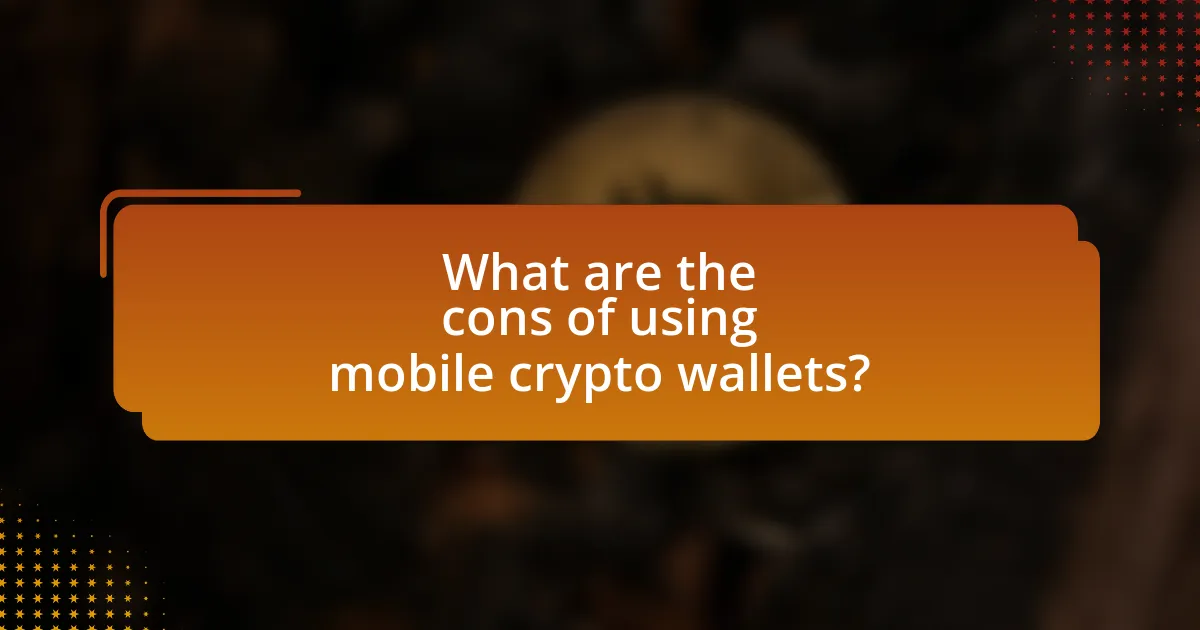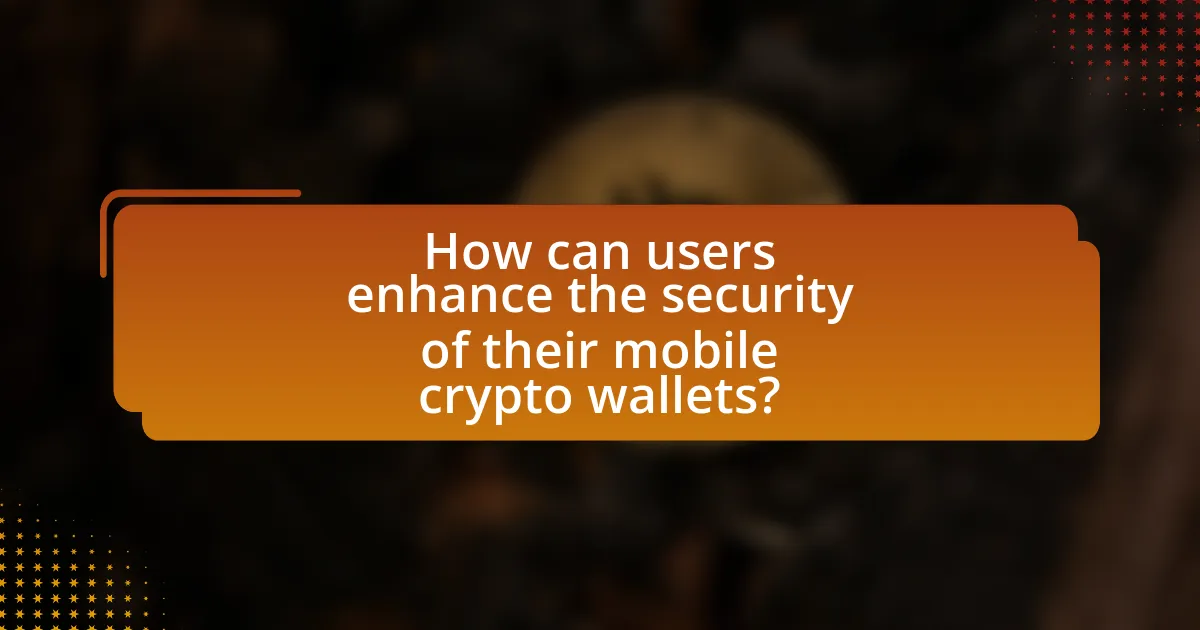Mobile crypto wallets are applications that enable users to store, send, and receive cryptocurrencies directly from their mobile devices, offering convenience and accessibility for managing digital assets. This article evaluates the security of mobile crypto wallets, discussing their functionality, types, and the importance of security features such as multi-factor authentication and encryption. It highlights the potential risks associated with mobile wallets, including malware and phishing attacks, and compares their security to other wallet types. Additionally, the article outlines best practices for enhancing wallet security and explores future trends and regulatory implications in the mobile crypto wallet landscape.

What are Mobile Crypto Wallets and Their Importance in Cryptocurrency?
Mobile crypto wallets are applications that allow users to store, send, and receive cryptocurrencies directly from their mobile devices. Their importance in cryptocurrency lies in their convenience and accessibility, enabling users to manage their digital assets on-the-go. According to a report by Statista, as of 2021, over 300 million cryptocurrency users globally rely on mobile wallets for transactions, highlighting their widespread adoption. Additionally, mobile wallets often incorporate security features such as biometric authentication and encryption, which enhance the protection of users’ funds.
How do Mobile Crypto Wallets function?
Mobile crypto wallets function by storing private and public keys on a mobile device, enabling users to send, receive, and manage cryptocurrencies. These wallets interact with blockchain networks to facilitate transactions, using the private key to sign transactions and the public key to verify them. The wallet software generates a unique address derived from the public key, allowing users to receive funds. Security features often include encryption, biometric authentication, and backup options to protect against unauthorized access and loss of funds. According to a report by Statista, as of 2023, mobile wallets account for a significant portion of cryptocurrency transactions, highlighting their growing importance in the digital currency ecosystem.
What types of mobile crypto wallets are available?
There are three main types of mobile crypto wallets available: hot wallets, cold wallets, and hardware wallets. Hot wallets are connected to the internet and allow for quick transactions, making them convenient for everyday use. Cold wallets, on the other hand, are offline and provide enhanced security, ideal for long-term storage of cryptocurrencies. Hardware wallets are a subset of cold wallets that store private keys on a physical device, offering a high level of security against online threats. Each type serves different user needs based on the balance between convenience and security.
What security features are commonly found in mobile crypto wallets?
Mobile crypto wallets commonly feature multi-factor authentication (MFA), encryption, and backup options. Multi-factor authentication enhances security by requiring users to provide two or more verification factors, making unauthorized access more difficult. Encryption protects sensitive data by converting it into a secure format that can only be read with the correct decryption key. Backup options allow users to securely store their wallet information, ensuring recovery in case of device loss or failure. These features collectively enhance the security of mobile crypto wallets, safeguarding users’ digital assets against theft and loss.
Why is security a critical concern for mobile crypto wallets?
Security is a critical concern for mobile crypto wallets because they store sensitive information, including private keys and transaction data, which are essential for accessing and managing cryptocurrencies. The mobile environment is particularly vulnerable to threats such as malware, phishing attacks, and device theft, which can lead to unauthorized access and loss of funds. According to a report by the cybersecurity firm CipherTrace, in 2020 alone, over $1.8 billion was lost to cryptocurrency theft, highlighting the significant risks associated with inadequate security measures in mobile wallets.
What are the potential risks associated with mobile crypto wallets?
Mobile crypto wallets carry several potential risks, including security vulnerabilities, loss of access, and phishing attacks. Security vulnerabilities arise from the fact that mobile devices can be compromised through malware or hacking, leading to unauthorized access to wallet funds. Loss of access can occur if users forget their passwords or lose their devices, resulting in permanent loss of cryptocurrency. Phishing attacks target users through deceptive messages or websites, tricking them into revealing sensitive information. According to a report by the Federal Trade Commission, consumers lost over $80 million to cryptocurrency scams in 2021, highlighting the prevalence of these risks.
How do mobile crypto wallets compare to other types of wallets in terms of security?
Mobile crypto wallets generally offer a lower level of security compared to hardware wallets but can be more secure than web wallets. Mobile wallets store private keys on the device, which can be vulnerable to malware and theft, whereas hardware wallets keep keys offline, providing enhanced protection against online threats. According to a report by the Blockchain Security Alliance, hardware wallets are considered the safest option due to their isolation from internet connectivity, while mobile wallets can implement security features like biometric authentication and encryption, which improve their security compared to web wallets that are susceptible to phishing attacks.
What are the pros of using mobile crypto wallets?
Mobile crypto wallets offer several advantages, including convenience, accessibility, and enhanced security features. Users can easily manage their cryptocurrencies on-the-go, as mobile wallets are typically user-friendly and allow for quick transactions. According to a report by Statista, as of 2023, over 60% of cryptocurrency transactions occur via mobile devices, highlighting the growing reliance on mobile wallets for everyday use. Additionally, many mobile wallets incorporate advanced security measures such as biometric authentication and encryption, which help protect users’ assets from unauthorized access.
How do mobile crypto wallets enhance user convenience?
Mobile crypto wallets enhance user convenience by providing easy access to cryptocurrencies through smartphones, allowing users to manage their assets anytime and anywhere. This accessibility is supported by features such as QR code scanning for quick transactions, user-friendly interfaces for seamless navigation, and integration with various decentralized applications. Additionally, mobile wallets often include built-in security measures like biometric authentication, which simplifies the login process while maintaining a high level of security. According to a report by Statista, the global mobile wallet market is projected to reach $7.58 trillion by 2027, indicating a growing preference for mobile solutions that prioritize user convenience.
What advantages do mobile crypto wallets offer in terms of accessibility?
Mobile crypto wallets provide significant advantages in terms of accessibility by allowing users to manage their cryptocurrencies anytime and anywhere through their smartphones. This portability enables immediate access to funds, facilitating quick transactions and real-time market engagement. Additionally, mobile wallets often feature user-friendly interfaces and integration with various services, enhancing the overall user experience. According to a report by Statista, as of 2023, over 6 billion smartphone users globally highlight the widespread potential for mobile crypto wallet adoption, further emphasizing their accessibility benefits.

What are the cons of using mobile crypto wallets?
Mobile crypto wallets have several cons, primarily related to security vulnerabilities. These wallets are susceptible to hacking, malware, and phishing attacks, which can lead to the loss of funds. For instance, a 2021 report by Chainalysis indicated that mobile wallets accounted for a significant portion of cryptocurrency thefts, highlighting their risk profile. Additionally, mobile devices can be lost or stolen, further exposing wallet contents to unauthorized access. Furthermore, the reliance on internet connectivity increases the risk of exposure to cyber threats. Overall, while mobile crypto wallets offer convenience, their security weaknesses present substantial risks for users.
What security vulnerabilities are associated with mobile crypto wallets?
Mobile crypto wallets are associated with several security vulnerabilities, including malware attacks, phishing scams, and insecure storage of private keys. Malware can compromise the device, allowing attackers to access wallet information and funds. Phishing scams often trick users into revealing sensitive information through fraudulent websites or applications. Additionally, if private keys are stored insecurely on the device, they can be easily extracted by malicious software or unauthorized users. According to a report by the Blockchain Security Alliance, over 60% of mobile wallet users have experienced some form of security breach, highlighting the prevalence of these vulnerabilities.
How can malware and phishing attacks compromise mobile crypto wallets?
Malware and phishing attacks can compromise mobile crypto wallets by exploiting vulnerabilities in the device’s operating system or user behavior. Malware can be installed through malicious apps or links, allowing attackers to access private keys and sensitive information stored in the wallet. Phishing attacks often involve deceptive messages or websites that trick users into providing their login credentials or recovery phrases, leading to unauthorized access to their wallets. According to a report by the Cybersecurity and Infrastructure Security Agency (CISA), mobile devices are increasingly targeted due to their widespread use for cryptocurrency transactions, highlighting the need for robust security measures to protect against these threats.
What role does user behavior play in the security of mobile crypto wallets?
User behavior significantly impacts the security of mobile crypto wallets by influencing how securely users manage their private keys and access credentials. For instance, poor practices such as using weak passwords, failing to enable two-factor authentication, or neglecting software updates can expose wallets to unauthorized access and theft. Research indicates that 90% of cyber incidents are attributed to human error, highlighting the critical role of user vigilance in maintaining wallet security. Additionally, users who engage in risky behaviors, such as downloading unverified apps or connecting to unsecured networks, further increase their vulnerability to attacks. Thus, user behavior is a pivotal factor in the overall security framework of mobile crypto wallets.
What are the limitations of mobile crypto wallets compared to hardware wallets?
Mobile crypto wallets have several limitations compared to hardware wallets, primarily in terms of security and control over private keys. Mobile wallets are more susceptible to malware and phishing attacks due to their reliance on internet connectivity and the potential for compromised mobile devices. In contrast, hardware wallets store private keys offline, significantly reducing the risk of unauthorized access. Additionally, mobile wallets often require users to trust third-party applications for security, while hardware wallets provide a more secure, self-custodial solution. This distinction is crucial, as a 2021 report by the Blockchain Security Alliance indicated that 70% of crypto thefts were linked to software vulnerabilities in mobile applications, underscoring the inherent risks associated with mobile wallets.
How does the storage method affect the security of mobile crypto wallets?
The storage method significantly impacts the security of mobile crypto wallets by determining how private keys are managed and protected. For instance, wallets that store private keys locally on the device are more vulnerable to malware and physical theft, as attackers can gain direct access to the keys. In contrast, wallets that utilize cloud storage or hardware wallets can offer enhanced security features, such as encryption and multi-factor authentication, reducing the risk of unauthorized access. According to a study by the European Union Agency for Cybersecurity, 90% of mobile malware targets financial applications, highlighting the importance of secure storage methods in protecting crypto assets.
What are the implications of losing access to a mobile device with a crypto wallet?
Losing access to a mobile device with a crypto wallet can result in the permanent loss of funds stored within that wallet. This occurs because many mobile crypto wallets do not have recovery options, meaning if the device is lost or damaged, the private keys necessary to access the cryptocurrency are also lost. According to a study by Chainalysis, approximately 20% of all Bitcoin is considered lost, often due to users losing access to their wallets. Without backup phrases or recovery keys, users cannot retrieve their assets, highlighting the critical importance of securing recovery information separately from the device.

How can users enhance the security of their mobile crypto wallets?
Users can enhance the security of their mobile crypto wallets by implementing strong passwords and enabling two-factor authentication (2FA). Strong passwords should be complex, combining letters, numbers, and symbols, making them difficult to guess. Two-factor authentication adds an extra layer of security by requiring a second form of verification, such as a text message or authentication app, which significantly reduces the risk of unauthorized access. According to a study by the Cybersecurity & Infrastructure Security Agency, enabling 2FA can prevent 99.9% of automated attacks, highlighting its effectiveness in securing accounts. Additionally, users should regularly update their wallet software to protect against vulnerabilities, as outdated software can be an easy target for hackers.
What best practices should users follow to secure their mobile crypto wallets?
To secure mobile crypto wallets, users should implement strong security measures such as enabling two-factor authentication (2FA), using strong and unique passwords, and keeping their software updated. Two-factor authentication adds an extra layer of security by requiring a second form of verification, significantly reducing the risk of unauthorized access. Strong passwords, ideally a mix of letters, numbers, and symbols, help protect against brute-force attacks. Regular software updates ensure that users benefit from the latest security patches, addressing vulnerabilities that could be exploited by attackers. According to a report by the Cybersecurity & Infrastructure Security Agency, 2FA can prevent 99.9% of automated attacks, highlighting its effectiveness in enhancing wallet security.
How can two-factor authentication improve wallet security?
Two-factor authentication (2FA) significantly enhances wallet security by requiring two forms of verification before granting access. This additional layer of security makes it more difficult for unauthorized users to access the wallet, as they would need both the password and a second factor, such as a code sent to a mobile device or generated by an authentication app. According to a study by Google and the University of California, Berkeley, 2FA can block up to 99.9% of automated attacks, demonstrating its effectiveness in protecting sensitive information.
What steps should users take if they suspect their wallet has been compromised?
If users suspect their wallet has been compromised, they should immediately stop using the wallet and transfer any remaining funds to a secure wallet. This action prevents further unauthorized access to their assets. Users should then change their passwords and enable two-factor authentication on all related accounts to enhance security. Additionally, they should monitor their transaction history for any unauthorized activity and report any suspicious transactions to their wallet provider. Finally, users should consider seeking professional assistance to assess the extent of the compromise and to recover any lost funds if possible.
What tools and resources are available for evaluating mobile crypto wallet security?
Tools and resources available for evaluating mobile crypto wallet security include security audits, penetration testing tools, and user reviews. Security audits assess the wallet’s code and architecture for vulnerabilities, while penetration testing tools like OWASP ZAP and Burp Suite simulate attacks to identify weaknesses. User reviews on platforms such as Reddit and Trustpilot provide insights into real-world experiences and potential security issues. Additionally, resources like the Mobile Security Testing Guide by OWASP offer comprehensive guidelines for evaluating mobile application security, including crypto wallets.
How can users assess the security features of different mobile crypto wallets?
Users can assess the security features of different mobile crypto wallets by examining key aspects such as encryption methods, two-factor authentication, backup options, and the wallet’s open-source status. Encryption methods protect user data and transactions, while two-factor authentication adds an extra layer of security against unauthorized access. Backup options ensure that users can recover their funds in case of device loss or failure. Additionally, wallets that are open-source allow for community scrutiny, which can enhance security through peer review. According to a study by the Cambridge Centre for Alternative Finance, wallets with robust security features significantly reduce the risk of hacks and theft, highlighting the importance of these assessments.
What resources provide updates on mobile wallet security threats?
Resources that provide updates on mobile wallet security threats include cybersecurity news websites, industry reports, and official advisories from financial institutions. Websites such as Krebs on Security and Threatpost regularly publish articles on emerging threats and vulnerabilities related to mobile wallets. Additionally, organizations like the Cybersecurity and Infrastructure Security Agency (CISA) issue alerts and updates on security issues affecting digital payment systems. Research reports from cybersecurity firms, such as Symantec and McAfee, also analyze trends in mobile wallet security, providing valuable insights into potential threats.
What are the future trends in mobile crypto wallet security?
Future trends in mobile crypto wallet security include the integration of biometric authentication, enhanced encryption methods, and the use of decentralized identity solutions. Biometric authentication, such as fingerprint and facial recognition, is becoming increasingly common, providing a higher level of security compared to traditional passwords. Enhanced encryption methods, including quantum-resistant algorithms, are being developed to protect against future threats posed by advancements in computing power. Additionally, decentralized identity solutions aim to give users more control over their personal information, reducing the risk of data breaches. These trends are supported by the growing need for robust security measures in response to the increasing frequency of cyberattacks targeting mobile wallets.
How is technology evolving to enhance mobile crypto wallet security?
Technology is evolving to enhance mobile crypto wallet security through advanced encryption methods, biometric authentication, and multi-signature protocols. Advanced encryption techniques, such as AES-256, protect user data and transaction information from unauthorized access. Biometric authentication, including fingerprint and facial recognition, adds an additional layer of security by ensuring that only authorized users can access the wallet. Multi-signature protocols require multiple private keys to authorize a transaction, significantly reducing the risk of theft. According to a report by the Blockchain Research Institute, the adoption of these technologies has led to a 30% decrease in successful hacking attempts on mobile wallets over the past two years, demonstrating their effectiveness in enhancing security.
What role will regulation play in the security of mobile crypto wallets?
Regulation will play a crucial role in enhancing the security of mobile crypto wallets by establishing standards and compliance requirements for wallet providers. These regulations can mandate security protocols, such as encryption and multi-factor authentication, which help protect users’ assets from theft and fraud. For instance, the Financial Action Task Force (FATF) has issued guidelines that encourage jurisdictions to implement measures that secure digital wallets, thereby promoting a safer environment for users. Additionally, regulatory oversight can lead to increased accountability among wallet providers, ensuring they adhere to best practices in cybersecurity, which further mitigates risks associated with mobile crypto wallets.


